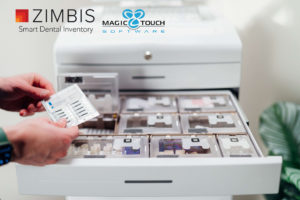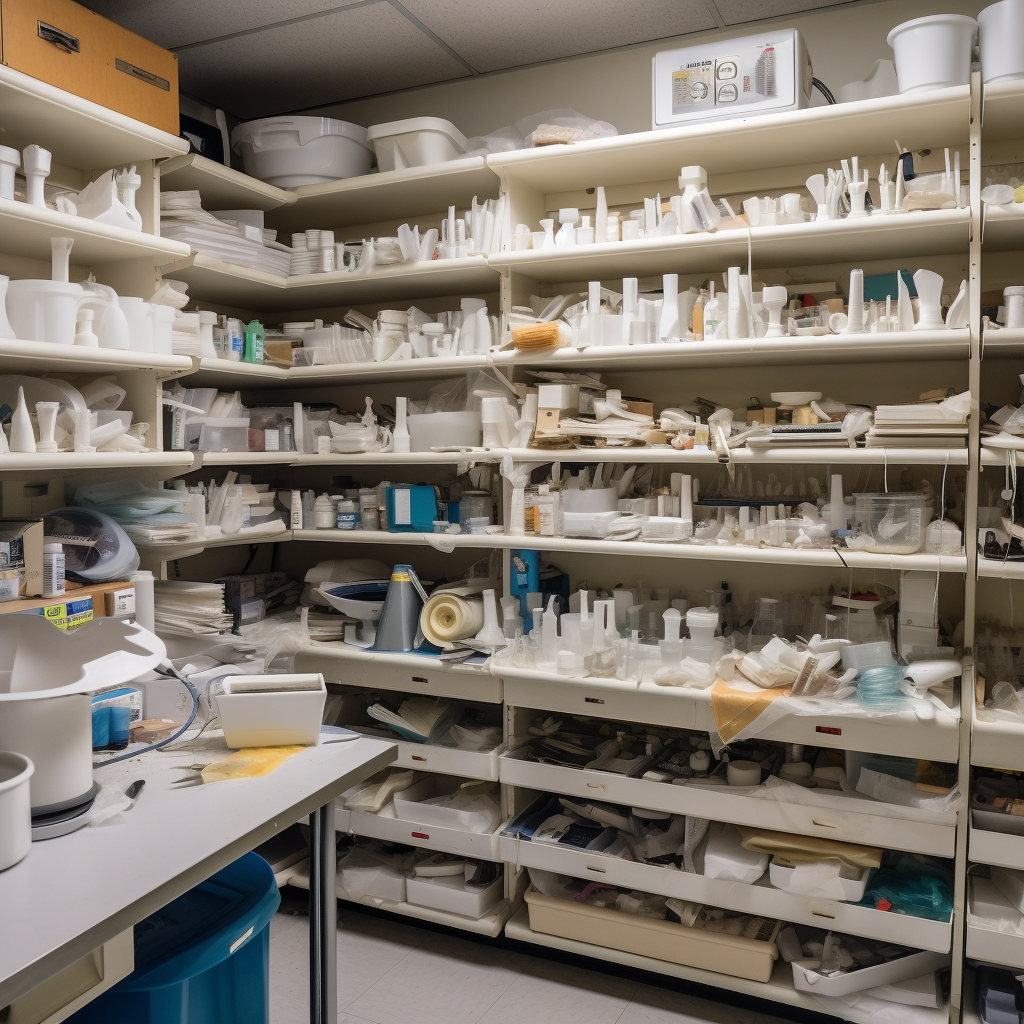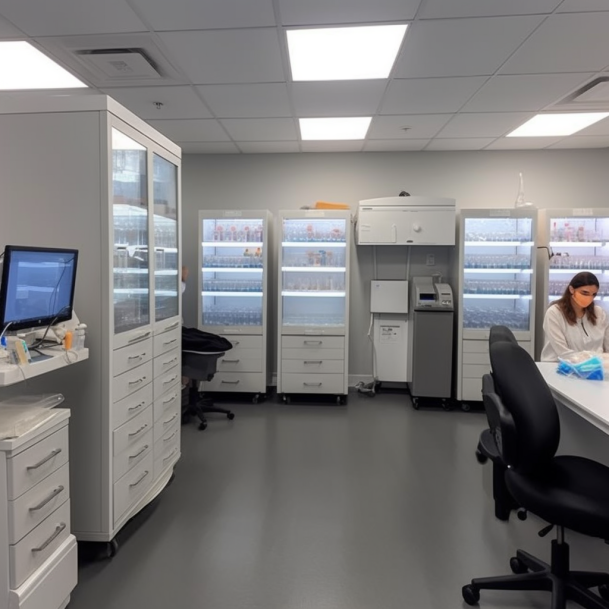
by David Avery | Oct 30, 2023 | News
Having been immersed in the world of dental laboratory economics for over three decades, I’ve observed, experienced, and participated in numerous shifts within our industry. Technological advancements have consistently been at the forefront of driving efficiency and quality in our labs. Today, there is a new technology that I firmly believe will be a cornerstone for labs in the coming decade: Automated Dispensing Cabinets (ADCs), also known in our industry as ‘Smart Cabinets.’
Streamlined Compliance with Lot Number Tracking
The FDA’s requirements for tracking lot numbers for implantable medical devices are non-negotiable. With patient safety at stake, the onus on labs to accurately track and report on these numbers is enormous. Traditional manual methods of doing so have proven time and again to be fallible, leading to inaccuracies that can have considerable implications both from a compliance and a patient safety standpoint.
Enter the smart cabinet, which inherently offers electronic and precise lot number tracking with every single dispense. The automation removes the scope for human error, ensuring that each item can be traced back to its source accurately and effortlessly, thus bolstering our adherence to FDA regulations and promoting patient safety.
An End to Tedious Inventory Counts
Inventory management has long been a time-intensive task in our labs. Staff would spend inordinate amounts of time manually counting zirconia disks, dental implants, 3D printer resin, and other essentials, often leading to discrepancies and inefficiencies.
With the ADCs, the need for manual counts vanishes. The system keeps a real-time, accurate track of every item, ensuring that we’re always aware of our inventory levels. This not only saves significant time for our staff but also guarantees the optimal utilization and rotation of stock.
Goodbye to Rush Orders and Hello to Cost Savings
One of the most exasperating scenarios in a lab is realizing that a critical item is out of stock, prompting an emergency overnight order, often accompanied by exorbitant shipping charges. ADCs, with their automated re-ordering capability, prevent such scenarios. When inventory levels approach the predetermined minimum, the system automatically generates an order, negating the need for rush orders and thus, ensuring cost-effectiveness.
Addressing the Elephant in the Room: Billing Errors
Billing errors are rife in our industry. Discrepancies in inventory counts, manual entry errors, and mismanagement of order logs all contribute to these issues, negatively impacting both the top line (revenue) and bottom line (profitability) of labs.
A fully integrated automated dispensing system offers a holistic solution. With every item being tracked electronically from the point of dispense to billing, the likelihood of billing errors plummets. This streamlined approach ensures that labs bill accurately for every item, enhancing revenue accuracy and improving profitability.
In Conclusion
The role of technology in the dental laboratory landscape has never been more pivotal. As we advance into a future dominated by precision, efficiency, and compliance, tools like Automated Dispensing Cabinets stand out as beacons of progress. Their ability to automate critical processes, ensure regulatory compliance, and eliminate prevalent challenges like billing errors positions them as invaluable assets in modern dental labs.
For those looking to future-proof their labs and remain at the forefront of quality, efficiency, and profitability, embracing ADCs isn’t just a recommendation—it’s a necessity.
by Joey Campagna | Sep 8, 2022 | News
Zimbis announces software integration and partnership with Magic Touch Software International, fully integrated smart inventory cabinets now on the horizon for all users of Magic Touch lab management software DLCPM.
Phoenix, Arizona: Zimbis, a division of CUBEX LLC and a leading provider of technology enabled healthcare services in the dental lab sector, has developed a bi-directional software integration between their smart cabinet inventory system and the Magic Touch suite of dental lab management products. The two companies have also announced a commercial partnership.
The Zimbis system facilitates complete, automated inventory management of critical supplies for any dental lab. Zimbis increases profit and efficiency for lab operators by reducing missed revenue and ensuring all critical items are automatically replenished before they run out of stock
“Our Dental Lab placements have really taken off over the past year as lab owners have looked to counter inflation by reducing inventory costs and billing errors. So, we asked, who are the top management software providers that we need to integrate with? And Magic Touch was one of the names at the top of that list.” said Louis Visser, DDS, President of Zimbis. “The team at Magic Touch has just been great to work with, and we couldn’t be more thrilled to bring this integration to the dental lab space.”
With this new software integration, Magic Touch users can dispense all desired parts for a case directly from the Zimbis smart cabinet without needing to enter the case information themselves – it will seamlessly sync with the Zimbis system. The exact costs for all parts will be transmitted back to Magic Touch with no additional input from the tech, ensuring that all charges are correct. FDA lot numbers are also logged for compliance purposes, and once the quantity-on-hand for an individual SKU falls below a pre-set inventory threshold, Zimbis will automatically re-order that SKU from the supplier so that costly overnight shipping and the anxiety of ‘stock outs’ become a thing of the past.
Zimbis Smart Inventory Cabinets are highly configurable to accommodate almost everything in a dental office or laboratory. Implants, abutments and other associated components are handled within Tower units featuring individually sealed compartments, while larger items such as zirconia discs, cerec blocks, printer resin, etc. are kept in secure Flex cabinets.
About ZIMBIS
ZIMBIS is a leading provider of innovative health care automation and cloud-based business intelligence solutions that enable the dental health providers to improve supply and medication management, cost and patient outcomes while at the same time increasing regulatory compliance. More information can be found at www.zimbis.com.
Media Contact:
Joey Campagna (CUBEX LLC)
(480) 268-7955
jcampagna@cubex.biz
About Magic Touch Software
Magic Touch Software is the leading Dental Lab Software Management System, servicing worldwide dental laboratories. For more than 19 years, Magic Touch has provided customers with end-to-end business management solutions including case management, accounting, sales, marketing, customer service, technician bench, route manager, integrations, and customer portal applications. For more information Visit https://magictouchsoftware.com/
Media Contact
Amir Bagheri
San Marcos, California 92078
amir@magictouchsoftware.com
(800) 714-6490
https://magictouchsoftware.com/
by Michael Dahl | Aug 19, 2022 | News
PHOENIX, Ariz. – August 18, 2022 – Zimbis, a division of CUBEX LLC and provider of medication and supply management technology, announced today the launch of a partnership with ACE SOUTHERN, a leading global provider of surgical products, including biologics, pharmaceuticals, and surgical supplies.
The partnership with ACE SOUTHERN supports Zimbis’ mission to provide clients with solutions and workflows that address their specific medication and supply requirements. This announcement expands ACE SOUTHERN’s order integration to restock inventory with product appearing in a customer’s shopping cart once inventory reorder levels are achieved.
“We very much look forward to our partnership with Zimbis,” said Michael Mancini, COO of ACE SOUTHERN. “ACE SOUTHERN looks forward to helping improve operational efficiencies so dental specialists can spend more time delivering quality patient care.”
“Our goal at Zimbis is to provide innovative solutions so our partners and clients can provide the best possible patient care,” said Louis Visser, DDS, President of Zimbis. “We’re excited to partner with ACE SOUTHERN and bring the benefits of this integration to the dental surgery market.”
For more information about Zimbis’ partnership with ACE SOUTHERN and the order integration workflow, please visit https://zimbis.com/acesouthern/
About Zimbis
Zimbis, a division of CUBEX LLC, is a market leader in developing and delivering innovative health care automation and business intelligence solutions to dentists, dental surgeons and dental laboratories. Zimbis offers a unique ability to meet the demands of a variety of dental environments by offering automated dispensing cabinets, wireless stockroom solutions, cloud-hosted software and more. Additional information can be found at www.zimbis.com
by Zimbis | Nov 1, 2021 | News

Jan Woods, Zimbis Regulatory Consultant
Written By Jan Woods
It’s been said and sadly realized all too late that once the DEA (Drug Enforcement Administration) gets into your practice, it can be difficult getting them out! Here’s a real eye opener, did you know that the average DEA fine is $15,040, per citation? Unfortunately, only one citation is rarely given by the DEA to a Practitioner. Yikes! So, what’s the best way to minimize your biggest risk and keep the DEA out of your practice? Should you just memorize and follow all state and federal Practitioner controlled substance regulations? Nope, the regulations are often confusing, contradictory, and constantly changing!
Did you know that the under the “Controlled Substance Act, the term “practitioner” is defined as a physician, dentist, veterinarian, scientific investigator, pharmacy, hospital, or other person licensed, registered, or otherwise permitted, by the United States or the jurisdiction in which the practitioner practices or performs research, to distribute, dispense, conduct research with respect to, administer, or use in teaching or chemical analysis, a controlled substance in the professional practice or research. Every person or entity that handles controlled substances must be registered with the DEA or be exempt by regulation from registration.” Source: Page 7 of the DEA Practitioner’s Manual.
Question: Do you know which controlled substance regulations take precedence in your practice? Is it the federal government (DEA), the state government, the state pharmacy board or the state dental board?
Answer: Whichever regulation is the most stringent!
That means you must know all the federal DEA regulations found in Title 21 CFR, 1300 to End, plus know all your state’s controlled substance regulations and then follow the most stringent regulation! One can get headache just trying to figure out where to start!
Even the simplest controlled substance regulations can be confusing. For example, knowing the difference between controlled substance medical waste destruction and expired and unwanted controlled substances destruction is often confusing. This leads to two of the most common violations cited by the DEA and state agencies. Read on to learn more.
Controlled Substance Medical Waste
How do you destroy your controlled substance medical waste? How do you destroy your expired or unwanted controlled substances? Let’s look at their definitions first and then the correct destruction methods per the DEA. Remember that your state’s destruction regs may differ from Federal DEA destruction regs, so always follow the most stringent regulations.
Controlled Substance Medical Waste is defined as “a controlled substance dispensed by a practitioner for immediate administration at the practitioner’s registered location, when the substance is not fully exhausted (e.g., some of the substance remains in a vial, tube, or syringe after administration but cannot or may not be further utilized)”. Source: Title 21 Code of Federal Regulations PART 1304 — RECORDS AND REPORTS OF REGISTRANTS CONTINUING RECORDS §1304.21 General Requirements.
Controlled Substance Medical Waste destruction is defined as “Destruction of a controlled substance dispensed by a practitioner for immediate administration at the practitioner’s registered location, when the substance is not fully exhausted (e.g., some of the substance remains in a vial, tube, or syringe after administration but cannot or may not be further utilized), shall be properly recorded in accordance with §1304.22(c), and such record need not be maintained on a DEA Form 41. Source: Title 21 Code of Federal Regulations PART 1304 — RECORDS AND REPORTS OF REGISTRANTS CONTINUING RECORDS §1304.21 General Requirements, Excerpted: Unfortunately, this regulation leaves us in a slightly confused state, doesn’t it? But further research provides us with a clearer solution.
US Bio Clean States: “Although the DEA states that it seeks to determine a variety of destruction methods, the only acceptable method of destruction for pharmaceutical wastage (i.e., drugs dispensed to a patient and not fully used, such as a single syringe with remaining controlled substance) at this time is incineration”.
“Therefore, the only method that currently meets the DEA requirement for both the non-retrievable and destruction standards involves a two-part process:
- Wasting the medication into a suitable neutralizing media, such as a Cactus Smart Sink or an Rx Destroyer. A solidifier can also be used for liquid only waste.
- Placing the neutralized container into a non-hazardous pharmaceutical waste container that will be sent out for incineration”.
Expired and Unwanted Controlled Substances
The Definition of Expired and Unwanted Controlled Substances is defined as a controlled substance that has expired or is no longer wanted by the Practitioner.
The Destruction of Expired and Unwanted Controlled Substances can be found in “Regulations for the Destruction of Expired or Unwanted Controlled Substances: Title 21 CFR §1317.05, Registrant Disposal’ Acceptable method are shown below:
(a) “Practitioner inventory. Any registered practitioner in lawful possession of a controlled substance in its inventory that desires to dispose of that substance shall do so in one of the following ways:
(1) Promptly destroy that controlled substance in accordance with subpart C of this part using an on-site method of destruction.
(2) Promptly deliver that controlled substance to a reverse distributor’s registered location by common or contract carrier pick-up or by reverse distributor pick-up at the registrant’s registered location;
(3) For the purpose of return or recall, promptly deliver that controlled substance by common or contract carrier pick-up or pick-up by other registrants at the registrant’s registered location to: The registered person from whom it was obtained, the registered manufacturer of the substance, or another registrant authorized by the manufacturer to accept returns or recalls on the manufacturer’s behalf; or
(4) Request assistance from the Special Agent in Charge of the Administration in the area in which the practitioner is located.
(i) The request shall be made by submitting one copy of the DEA Form 41 to the Special Agent in Charge in the practitioner’s area. The DEA Form 41 shall list the controlled substance or substances which the registrant desires to dispose.
(ii) The Special Agent in Charge shall instruct the registrant to dispose of the controlled substance in one of the following manners:
(A) By transfer to a registrant authorized to transport or destroy the substance;
(B) By delivery to an agent of the Administration or to the nearest office of the Administration; or
(C) By destruction in the presence of an agent of the Administration or other authorized person.
(5) In the event that a practitioner is required regularly to dispose of controlled substances, the Special Agent in Charge may authorize the practitioner to dispose of such substances, in accordance with subparagraph (a)(4) of this section, without prior application in each instance, on the condition that the practitioner keep records of such disposals and file periodic reports with the Special Agent in Charge summarizing the disposals. The Special Agent in Charge may place such conditions as he/she deems proper on practitioner procedures regarding the disposal of controlled substances.”
Please note Section (a)(2) is the DEA’s preferred method for destroying unwanted or expired controlled substances. Additionally, the other destruction methods listed above require DEA written approval with destruction in the presence of a DEA Agent or other authorized person. Well, I don’t know about you, but I don’t want to invite the DEA into any practice, do you?
A DEA Form 41 must be used when destroying expired or unwanted controlled substances. It’s imperative that you select a DEA-registered reverse distributor for the destruction of your expired or unwanted controlled substances.
Again, keep in mind that the only exception to the federal regulation cited here, would be more stringent state regulations. Additionally, it’s also important to remember regulations change frequently, so doctors (aka practitioners), managers and licensed staff members should access them frequently to ensure complete compliance.
To add further insult to injury, in addition to a DEA citation, the EPA can also fine a Practitioner a minimum of $37,500 per violation, for disposing of your pharmaceutical waste incorrectly!
Unfortunately, the regulations discussed in this blog represent only a fraction of the basic regulations you need to stay current, complete, and accurate with the DEA and state controlled substance regulations daily! But I hope that you are less confused than when we started. Please stay tuned for more blogs on DEA compliance soon.
Here are two important takeaways from this blog to help you reduce your risk and improve compliance. 1.) Know the difference between controlled substance medical waste and expired and unwanted controlled substances and follow the correct destruction method for each one.
2.) Familiarize yourself with all state and federal controlled substance regulations and follow the most stringent regulation.
If you would like an easy way to improve your controlled substance compliance and reduce your risk, consider buying an automated dispensing cabinet. Zimbis has all sizes of automatic dispensing cabinets to fit your practice size. Contact a Zimbis representative at 480.399.3436 for further information.
Jan Woods is a previous practice owner, seasoned regulatory compliance expert, consultant, author, and frequent speaker at national conferences. She is available to help you and your practice to achieve regulatory compliance with your controlled substances, improve your logs and recordkeeping and perform a mock DEA audit, etc. Contact Ms. Woods today at jan@askjanforhelp.com or via telephone at 913-302-4999.
REFERENCES:
- Title 21 of the Code of Federal Regulations (CFR), Sections 1300 to end.
- DEA’s Practitioner Manual is available online, but at the time of this writing it is being updated.
- Pharmacist’s Manual: An informational outline of the Controlled Substances Act. US Department of Justice Drug Enforcement Administration Diversion Control Division. 2020.
DISCLAIMER: The government creates changes and updates regulations frequently. As of August 2021, the information contained in this blog is current. Remember to check with the various governmental agencies or your attorney for changes that may affect your practice.
by Zimbis | Sep 21, 2021 | News
PHOENIX, Sept. 21, 2021 /PRNewswire/ — CUBEX LLC, the leading provider of pharmacy and supply management technology to the animal health market and dental markets, announced the appointment of Chris Hayden as Chief Revenue Officer. As CRO, overseeing both CUBEX and ZIMBIS, Chris will focus on all aspects of go-to-market plans, from strategy to sales and marketing execution.
markets, announced the appointment of Chris Hayden as Chief Revenue Officer. As CRO, overseeing both CUBEX and ZIMBIS, Chris will focus on all aspects of go-to-market plans, from strategy to sales and marketing execution.
Chris brings over 25 years of sales and executive leadership to this new role. With a primary focus in capital medical device and software sales, his particular focus has been in diagnostics and inventory automation. Chris has spent the last 15 years in senior roles with Pyxis, Cardinal Health / Carefusion and BD, while leading the national sales for Pyxis with revenue accountability of $1B. Since 2017, he has overseen BD’s Life Sciences and Diagnostics business for the East Coast accountable for over $600M in Revenue. Prior to that, he spent 4 years at Cerner Corporation overseeing their pharmacy enterprise by managing national sales in the US and Canada, driving a 70% increase in sales during that period through both organic growth and the acquisition of Bridge medical as a tuck in to the product portfolio.
Earlier in Chris’s career, when automated dispensing was still in its relative infancy in the human acute care space, he was hired by Pyxis to help launch the new markets division and drive significant growth in the alternate care marketplace. That experience, and all that has followed, has brought him full circle to CUBEX LLC. “My entire career has been leading up to this moment,” said Chris. “I’ve learned so much about what it takes for leading-edge inventory technology like CUBEX and ZIMBIS to become a standard of care that the majority of the market considers essential. I can’t wait to get started.”
“Chris is without question the perfect person for this role,” said Anton Visser, CEO and Co-Founder of CUBEX. Chris was a colleague of Anton’s at Pyxis during the company’s formative years, and the two have retained a connection throughout their respective careers. “2021 has been our best year to date at CUBEX, and Chris’ senior leadership experience with several multi-national industry leaders, as well as his relentless creativity in developing new revenue streams, are exactly what we need at to continue that success.”
Chris a graduate of Towson University in Towson, MD. He holds a Bachelor of Science Degree in Business with a concentration in Marketing. He resides in Middletown, DE with his three daughters, Lauren-16, Avery-14, and Sydney-12, and the most recent addition to the family, a Vizsla puppy named Bruno. In his free time Chris enjoys boating on the Chesapeake Bay, golfing and of course watching his girls play in their various sporting events.










 markets, announced the appointment of
markets, announced the appointment of